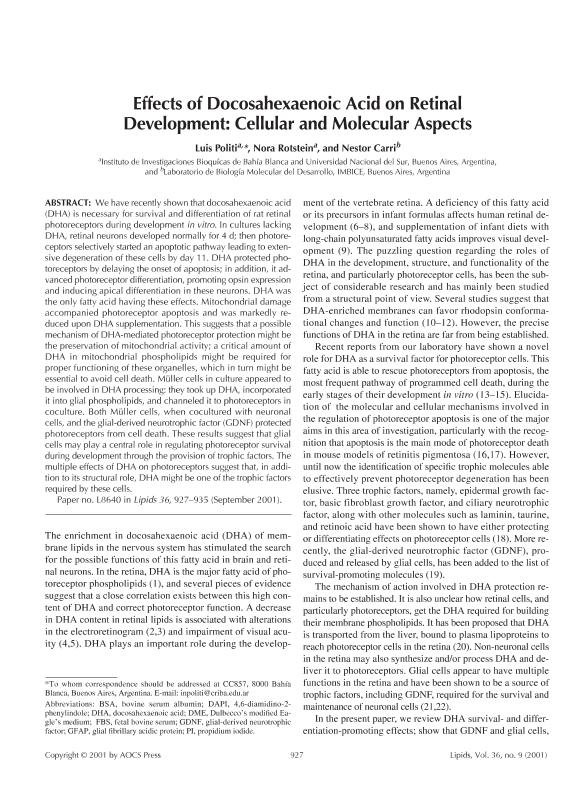Mostrar el registro sencillo del ítem
dc.contributor.author
Politi, Luis Enrique

dc.contributor.author
Rotstein, Nora Patricia

dc.contributor.author
Carri, Nestor Gabriel

dc.date.available
2018-07-13T18:46:20Z
dc.date.issued
2001-09
dc.identifier.citation
Politi, Luis Enrique; Rotstein, Nora Patricia; Carri, Nestor Gabriel; Effects of docosahexaenoic acid on retinal development: Cellular and molecular aspects; Springer Heidelberg; Lipids; 36; 9; 9-2001; 927-935
dc.identifier.issn
0024-4201
dc.identifier.uri
http://hdl.handle.net/11336/52075
dc.description.abstract
We have recently shown that docosahexaenoic acid (DHA) is necessary for survival and differentiation of rat retinal photoreceptors during development in vitro. In cultures lacking DHA, retinal neurons developed normally for 4 d; then photoreceptors selectively started an apoptotic pathway leading to extensive degeneration of these cells by day 11. DHA protected photoreceptors by delaying the onset of apoptosis; in addition, it advanced photoreceptor differentiation, promoting opsin expression and inducing apical differentiation in these neurons. DHA was the only fatty acid having these effects. Mitochondrial damage accompanied photoreceptor apoptosis and was markedly reduced upon DHA supplementation. This suggests that a possible mechanism of DHA-mediated photoreceptor protection might be the preservation of mitochondrial activity; a critical amount of DHA in mitochondrial phospholipids might be required for proper functioning of these organelles, which in turn might be essential to avoid cell death. Müller cells in culture appeared to be involved in DHA processing: they took up DHA, incorporated it into glial phospholipids, and channeled it to photoreceptors in coculture. Both Müller cells, when cocultured with neuronal cells, and the glial-derived neurotrophic factor (GDNF) protected photoreceptors from cell death. These results suggest that glial cells may play a central role in regulating photoreceptor survival during development through the provision of trophic factors. The multiple effects of DHA on photoreceptors suggest that, in addition to its stiuctural role, DHA might be one of the trophic factors required by these cells.
dc.format
application/pdf
dc.language.iso
eng
dc.publisher
Springer Heidelberg

dc.rights
info:eu-repo/semantics/openAccess
dc.rights.uri
https://creativecommons.org/licenses/by-nc-sa/2.5/ar/
dc.subject
Docosahexaenoic Acid
dc.subject
Retinal Photoreceptors
dc.subject.classification
Otras Ciencias Biológicas

dc.subject.classification
Ciencias Biológicas

dc.subject.classification
CIENCIAS NATURALES Y EXACTAS

dc.title
Effects of docosahexaenoic acid on retinal development: Cellular and molecular aspects
dc.type
info:eu-repo/semantics/article
dc.type
info:ar-repo/semantics/artículo
dc.type
info:eu-repo/semantics/publishedVersion
dc.date.updated
2018-07-11T14:11:00Z
dc.journal.volume
36
dc.journal.number
9
dc.journal.pagination
927-935
dc.journal.pais
Alemania

dc.journal.ciudad
Heidelberg
dc.description.fil
Fil: Politi, Luis Enrique. Consejo Nacional de Investigaciones Científicas y Técnicas. Centro Científico Tecnológico Conicet - Bahía Blanca. Instituto de Investigaciones Bioquímicas de Bahía Blanca. Universidad Nacional del Sur. Instituto de Investigaciones Bioquímicas de Bahía Blanca; Argentina
dc.description.fil
Fil: Rotstein, Nora Patricia. Consejo Nacional de Investigaciones Científicas y Técnicas. Centro Científico Tecnológico Conicet - Bahía Blanca. Instituto de Investigaciones Bioquímicas de Bahía Blanca. Universidad Nacional del Sur. Instituto de Investigaciones Bioquímicas de Bahía Blanca; Argentina
dc.description.fil
Fil: Carri, Nestor Gabriel. Consejo Nacional de Investigaciones Científicas y Técnicas. Centro Científico Tecnológico Conicet - La Plata. Instituto Multidisciplinario de Biología Celular. Provincia de Buenos Aires. Gobernación. Comisión de Investigaciones Científicas. Instituto Multidisciplinario de Biología Celular. Universidad Nacional de La Plata. Instituto Multidisciplinario de Biología Celular; Argentina
dc.journal.title
Lipids

dc.relation.alternativeid
info:eu-repo/semantics/altIdentifier/url/https://link.springer.com/article/10.1007/s11745-001-0803-8
dc.relation.alternativeid
info:eu-repo/semantics/altIdentifier/doi/http://dx.doi.org/10.1007/s11745-001-0803-8
Archivos asociados
